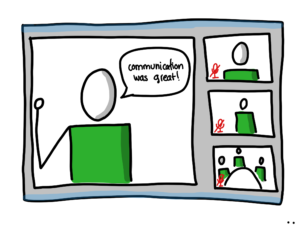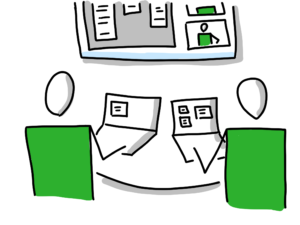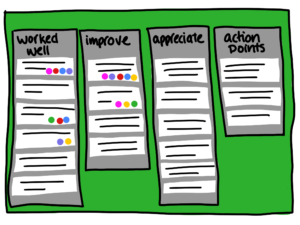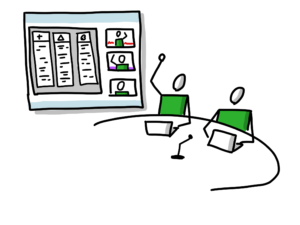Meaningful inclusive retrospectives are possible with distributed teams. Let’s talk about the basics you need to have in place, how you can facilitate a distributed retrospective, and what to look out for. This guide is based on the retrospective format that we used at LRF Media. The retrospective participants included 5 team members at the office in Stockholm, one person working from home, and 2 people working at the Kraków office.
The Basics
- Video conferencing solution. Something you can use to stream from all locations, and also share the screen. E.g. Google Hangouts, Zoom, Appear:in, Skype, Slack.
- Camera, and microphone/speaker system. The team members in Kraków, as well as the person working from home, used their own computers, so the built in cameras worked well. The group in the Stockholm office used a camera that showed everybody in the room. You should invest in a good microphone/speaker system for your setup as well, we suffered from bad sound quality on and off in the conference room.
- Online retrospective/whiteboard solution. There are many out there, including interactive whiteboards like the one my colleague Henrik Kniberg has made! If you already have a license then use the product you have. We used Trello! It’s a bit unconventional, but it worked really well, and we didn’t need to add yet another product/login/url.
Agenda and facilitation
 The agenda can follow a typical co-located retrospective agenda. In this case I’ll go over how I facilitated a “What worked well”, “What can be improved” retrospective using Trello. I would definitely use a whiteboard solution if I were doing a timeline as well, but we didn’t do that for this retrospective.
The agenda can follow a typical co-located retrospective agenda. In this case I’ll go over how I facilitated a “What worked well”, “What can be improved” retrospective using Trello. I would definitely use a whiteboard solution if I were doing a timeline as well, but we didn’t do that for this retrospective.
- Check in – It’s really important to make sure that everybody’s voice is heard, even more so when face to face interaction is significantly reduced. Start by asking how the team felt about the sprint, for example. Make sure that everybody gets a chance to say something. Be very clear on the order that you’ll use to keep the meeting moving.
- Gathering input – We created columns in Trello: “What worked well”, “What can be improved” and “Appreciations”. Each person got to add their notes as cards to the respective columns. You can collaborate real-time simultaneously, which we did by making sure everybody had a computer and login to Trello.

- Read appreciations out loud – I really want to give a shout out to “appreciations” especially in a distributed retrospective. Most teams are not good at giving feedback even when they work face to face. So before we got to work on improvements each participant got to read the appreciations they had added to the Trello board out loud.
- Grouping – Now it’s time to look at the positives and changes. Instead of visually grouping the cards in Trello we went through the cards and removed all duplicate notes. This gives the added bonus of allowing people to clarify what they mean.
- Vote for discussion topics – We voted for a card by adding ourselves as members on the card! It was very easy to see which topics got the most votes, and the process was relatively quick as everybody could vote at the same time.
- Discuss – As with any retrospective, it’s good to limit the number of points discussed, pick the top 2 or 3 and open the floor for discussion. It’s really important to allow for longer silences due to lag time and people not being sure if it’s ok to start talking. As a facilitator you can explicitly ask if anyone wants to comment. Don’t forget people who aren’t at your own location.
- Documenting Action points – We added a fourth column to our Trello board. Each action point was written as a card description.
- Close the retro – Ask for feedback on how to improve, and thank all the participants.

Conclusions
Well, this sounds really easy.. There were no problems?
- The microphone. Make sure you have a working solution given the number of people who are participating and the shape of the space you’re in.
- It is easy to just talk to the people sitting in the same room. Especially when the board is projected on the screen. I would love to try this retrospective out with each person sitting at their own desk with a headset. I think this would put everybody on even footing.
- You are influenced by what other people write. As soon as the notes started showing up on the Trello board it was difficult to not be influenced by what other people wrote. It would be nice to have a solution where the cards are face down and you can flip them over, or that you can stop syncing until everybody’s done writing. Otherwise it was great having Trello update so quickly!
Final thoughts
We were really happy with the simplicity and collaborative power that Trello offered. This was one of the most successful distributed retros I’ve participated in, and it opened up the possibility for someone working from home to easily participate. Finally, it’s really in the attitude, the team at LRF Media were keen to make sure that distributed development worked and they were all willing to meet each other halfway.
Get in touch via my homepage if you have questions or comments!




Thanks for sharing! Two thoughts/additions:
– ‘I would love to try this retrospective out with each person sitting at their own desk with a headset’: we noticed this in standup too: either have everybody behind a computer or nobody. Mixed works less well.
– ‘You are influenced by what other people write’: wouldn’t it be possible to ask people to write their notes in NotePad first, and then simultaniously start copy-pasting these to Trello after everybody is done writing?
Thanks for the input! Nice to hear that having stand up at your own desk worked well. I’ll update if we go the NotePad route.
Hi Yassal,
thanks for sharing! We use Realtimeboard for remote work and there you can actually agree to work on different parts of the board and THEN combine the notes so that you don’t get influenced by others. It can also be pre-structured for other retrospective formats (sailing boat, Start/Stop/Continue, etc.). Might be a viable, more flexible alternative to Trello – unless you need the cards in Trello to post-process them (although there might be a way to transfer them).
Thanks for the tip!
We use goreflect.com, it’s free and allows you to mask everyone’s cards so you are not influenced by what other people write. I get everyone to enter their points before the retro starts.
It also has an Action section and you can vote on cards too.
I’ve not tried having everyone sitting at their own desk and it is something I might try.
We tend to try and discuss everything which can be a squeeze, but will give voting a go. Do you give each participant a certain number of votes?
Can you expand on what you meant by ‘Be very clear on the order that you’ll use to keep the meeting moving’?
Thanks for sharing Yassal !
Key thing is to have good sound quality, otherwise it gets messy.
I use mentimeter.com when facilitating retros for distributed teams, one great thinig is that you can “mask/hide results” members input until you display them. Besides that, you also can have voting and much more.
And for the record, I do not work at mentimeter and have other interest in that tool. 🙂
Great article
Sorry if it’s already been mentioned but we use https://rapport.leanloop.co.uk for distributed retros
Nothing is quite as good as being in the same room but this is the tool that has stayed out of our way most and let us worry about the retro format and content
Thanks for the suggestion!
Thanks a lot, I liked your technique of deleting duplicates instead of grouping them.
our team too ended up using Trello. We found out that it works surprizingly well, its constraints actually making the retrospective easier to run! We tried different tools, and Trello remains our favorite, you can find the full story here https://bit.ly/2H53LTM.
We even ended up creating a Trello team filled up with retrospective activity templates, you can find them here (https://trello.com/agileretrospectives)
Thanks again for you post
Nice write up of what you guys tried! Thanks for sharing.
Yassal, I translated your great article into Russian. Look here: https://leadstartup.ru/db/remote-retrospective
Thank you for sharing the experience! 🙂